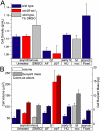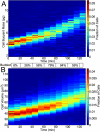Measurement of mass, density, and volume during the cell cycle of yeast
- PMID: 20080562
- PMCID: PMC2824314
- DOI: 10.1073/pnas.0901851107
Measurement of mass, density, and volume during the cell cycle of yeast
Abstract
Cell growth comprises changes in both mass and volume--two processes that are distinct, yet coordinated through the cell cycle. Understanding this relationship requires a means for measuring each of the cell's three basic physical parameters: mass, volume, and the ratio of the two, density. The suspended microchannel resonator weighs single cells with a precision in mass of 0.1% for yeast. Here we use the suspended microchannel resonator with a Coulter counter to measure the mass, volume, and density of budding yeast cells through the cell cycle. We observe that cell density increases prior to bud formation at the G1/S transition, which is consistent with previous measurements using density gradient centrifugation. To investigate the origin of this density increase, we monitor relative density changes of growing yeast cells. We find that the density increase requires energy, function of the protein synthesis regulator target of rapamycin, passage through START (commitment to cell division), and an intact actin cytoskeleton. Although we focus on basic cell cycle questions in yeast, our techniques are suitable for most nonadherent cells and subcellular particles to characterize cell growth in a variety of applications.
Conflict of interest statement
The authors declare no conflict of interest.
Figures







Similar articles
-
Rapid determination of cell mass and density using digitally controlled electric field in a microfluidic chip.Lab Chip. 2014 Nov 21;14(22):4426-34. doi: 10.1039/c4lc00795f. Lab Chip. 2014. PMID: 25254511
-
Yeast-phase cell cycle of the polymorphic fungus Wangiella dermatitidis.J Bacteriol. 1980 Nov;144(2):721-31. doi: 10.1128/jb.144.2.721-731.1980. J Bacteriol. 1980. PMID: 7430070 Free PMC article.
-
SBF cell cycle regulator as a target of the yeast PKC-MAP kinase pathway.Science. 1997 Mar 21;275(5307):1781-4. doi: 10.1126/science.275.5307.1781. Science. 1997. PMID: 9065400
-
Physical Cytometry: Detecting Mass-Related Properties of Single Cells.ACS Sens. 2022 Jan 28;7(1):21-36. doi: 10.1021/acssensors.1c01787. Epub 2022 Jan 3. ACS Sens. 2022. PMID: 34978200 Review.
-
Ras-related GTPases and the cytoskeleton.Mol Biol Cell. 1992 May;3(5):475-9. doi: 10.1091/mbc.3.5.475. Mol Biol Cell. 1992. PMID: 1611153 Free PMC article. Review.
Cited by
-
Magnetic levitation of single cells.Proc Natl Acad Sci U S A. 2015 Jul 14;112(28):E3661-8. doi: 10.1073/pnas.1509250112. Epub 2015 Jun 29. Proc Natl Acad Sci U S A. 2015. PMID: 26124131 Free PMC article.
-
Scaling of Subcellular Structures.Annu Rev Cell Dev Biol. 2020 Oct 6;36:219-236. doi: 10.1146/annurev-cellbio-020520-113246. Epub 2020 Jun 30. Annu Rev Cell Dev Biol. 2020. PMID: 32603615 Free PMC article. Review.
-
Differential scaling between G1 protein production and cell size dynamics promotes commitment to the cell division cycle in budding yeast.Nat Cell Biol. 2019 Nov;21(11):1382-1392. doi: 10.1038/s41556-019-0413-3. Epub 2019 Nov 4. Nat Cell Biol. 2019. PMID: 31685990
-
Quantifying condition-dependent intracellular protein levels enables high-precision fitness estimates.PLoS One. 2013 Sep 25;8(9):e75320. doi: 10.1371/journal.pone.0075320. eCollection 2013. PLoS One. 2013. PMID: 24086506 Free PMC article.
-
Transverse mechanical properties of cell walls of single living plant cells probed by laser-generated acoustic waves.Planta. 2014 May;239(5):1129-37. doi: 10.1007/s00425-014-2045-y. Epub 2014 Mar 11. Planta. 2014. PMID: 24615232
References
Publication types
MeSH terms
Substances
Grants and funding
LinkOut - more resources
Full Text Sources
Other Literature Sources
Molecular Biology Databases

